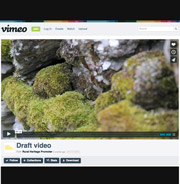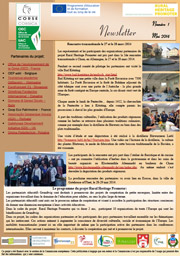Visit to Považská Bystrica
The final meeting of the Rural Heritage Promoter project took place in Slovakia at Považská Bystrica on the 29/30 June 2015.
The host for the visit was the organisation EuroKoncept 21.
The meeting was held in the recently restored 17th century manor of Jasenica, one of the examples of good practice in heritage promotion presented to the meeting by local representatives. Presentations were also given on work on the nearby ruined castle of Bystrica and by a representative of the local heritage office.
The local television channel inteviewed a number of the partners about the challenges they face in their own heritage projects in their own countries.
In the afternoon the group visited the ruined castle of Brystica, currently undergoing consolidation work as part of a national programme.
Later the group visited the Manínska Tiesnava gorge, before dinner in the former school created by the writer Peter Jilemnicky in the years 1932-36, and now an inn.
For the second day of the visit, the group travelled to see the Rajecká Lesná Bethlehem and the wooden, painted houses of Cicmany.
The Bethlehem model was created in wood by the master woodworker Josef Pekara in the village of Rajecka Lesna. It took 15 years to complete this unique work on show in the Basilica of the Virgin Mary. It was inaugurated in a special ceremony in 1995 with the central part complete. The work was finally completed in 2000.
As its centre the model presents the birth of Christ in Bethlehem, but equally the story of the Slovak nation. Bethlehem is presented in the heart of the Slovak heritage surrounded by traditional Slovak life and work: shepherds; miners; wine-making; agriculture and traditional industries. Backing the tableau are Slovak castles (Devín, Bratislava, Trencín, Orava) and cathedrals (Nitra, Trnava, Spišská Kapitula, Košice, Žilina), and symbols of the Slovak landscape like the Tatra mountains. Nearly 300 individuals are represented, many moving. The whole tableau is 8.5m long, 2.5m deep, and 3m high. It is one of the largest sculpted Bethlehems in Europe, and in wood, in the world.
Cicmany Cicmany is a village situated at 655m in the mountains of Staržovské vrchy, close by the source of the Rajcanka River. It is first recorded in 1272.
The economy of the village was agriculture along with the rearing of cattle and sheep. This was complemented by additional trades labouring in the forest or as glaziers. After the Great War, they also plied their trade as hawkers of haberdashery and footwear. Some went to work in France, Austria, Germany, the United States or Canada as seasonal workers, where some of them ended up settling permanently. After the Second World War, the inhabitants left the village to work in the nearby cities in factories returning to the village at weekends the cottages maintained as the traditional family home.
There were major fires in the years 1907 and 1921. New houses were built just like the originals - in wood. The ornamental decoration of houses was initially to protect the wood. Current patterns have been used since 1921 and are inspired by local embroidery patterns. All the vernacular houses have had heritage listing since 1977.
Until the early 20th century, the town kept the traditional form of the family, this being a large household. The farmer lived with his wife, and his married son with their wives and children. The property was used in common. Much of the room - the only warm place in the house - was occupied by a large oven/cooking area with two to three large fires. The room layout was simple - the benches around the walls, shelves for dishes, table and bed. The children slept in the attics in the upper part of the house. Granaries were dark, unheated with a bed and painted chest in which the daughter kept her own property.
White dominates the traditional dress, the color of the fabric originally produced by the locals - linen cloth. The costumes have a rich embrodered decoration, with lace and beads. The colours white, yellow, orange and ocher are mainly used.
Považie Museum in Žilina established the first museum in the one-story house, the house of Raden, in 1967, where jobs, traditional costumes and folk art were presented. In 1982, the house No. 42 was developed for visitors; you can see the presentation of housing in the early20th century. The traditional culture of the inhabitants of Cicmany holds a unique place in Slovakian culture.
http://ruralheritagepromoter.org/index.php/en/the-visits/81-visit-to-povazska-bystrica#sigProGalleriac42ea22a9d






